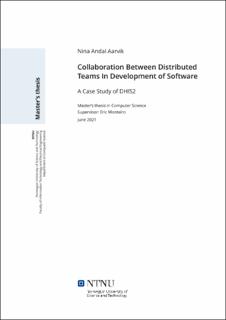| dc.contributor.advisor | Monteiro, Eric | |
| dc.contributor.author | Aarvik, Nina Andal | |
| dc.date.accessioned | 2021-09-16T16:00:24Z | |
| dc.date.available | 2021-09-16T16:00:24Z | |
| dc.date.issued | 2021 | |
| dc.identifier | no.ntnu:inspera:74730513:33586933 | |
| dc.identifier.uri | https://hdl.handle.net/11250/2778706 | |
| dc.description.abstract | Teknologi har revolusjonert hvordan de fleste industrier arbeider. Ansatte trenger ikke lenger å jobbe fra samme arbeidssted til samme tid for å kunne samarbeide og koordinere arbeidet. Dette tilrettelegger for store og komplekse systemer som kan utfolde seg over landegrenser.
Dette studiet tar sikte på å bidra med strategier ved oppskalering av et system med geografisk distribuerte team som samarbeider i utviklingsprosessen. Studiet forsøker å avsløre hvilke ressurser som er fordelaktige i utviklingsarbeidet, samt potensielle negative effekter disse ressursene kan føre til.
Systemet beskrevet i denne artikkelen omhandler utviklingen av et helseinformasjonssystem med team spredt over hele kloden. Prosjektet krever dermed gruppeprogramvare for å kunne samarbeide. Forskningen er basert på flere metoder for datainnsamling, inkludert kvalitative intervjuer med flere interessenter, samt analyse av tilgjengelige gruppevarer og ressurser på nett. Studien analyserer det sosio-tekniske perspektivet. Det er basert på CSCW-feltet, relevansen av gruppevare i samarbeidsarbeid hvor fysiske møter ikke er gjennomførbare, og viktigheten av dedikerte team som er posisjonert nærme sluttbrukeren.
Funnene antyder at flere distinkte arenaer er nødvendige for å opprettholde et samarbeidsmiljø, og at tett samarbeid mellom utviklingsteam og sluttbrukere er avgjørende for systemets suksess. Det indikerer også at ved introduksjon av lokale team som er nærme sluttbrukeren og som rapporterer tilbake til det globale teamet, innføres risikoen for å filtrere informasjonen som kommer fra sluttbrukeren. | |
| dc.description.abstract | Technology has revolutionized how the majority of all industries perform their work. Workers no longer have to be situated in the same place and time to collaborate and coordinate, allowing for large and complex projects spanning all over the world.
This study aims to contribute with strategies when scaling up a system with geographically distributed teams collaborating in the development process. It attempts to disclose which resources are beneficial in the development work and the potential negative impact these resources might have.
The case described in this paper is the development of a health information management system that currently has teams dispersed throughout the globe and that requires groupware to collaborate. The research was based on multiple methods for data collection, including qualitative interviews with several ecosystem actors and analysis of the available groupware and online resources.
The study analyses the socio-technical perspective. It is based on the CSCW field, the relevance of groupware in collaboration work where physical meetings are not feasible, and the importance of dedicated teams situated close to the end users.
The discoveries imply that several distinct arenas are necessary to maintain a collaborative environment and that close collaboration between development teams and end users is vital regarding the success of the system.
It also implies that introducing local teams that are situated close to the end users reporting back to the core team introduces the risk of filtering information from end users. | |
| dc.language | eng | |
| dc.publisher | NTNU | |
| dc.title | Collaboration Between Distributed Teams In Development of Software: A Case Study of DHIS2 | |
| dc.type | Master thesis | |
